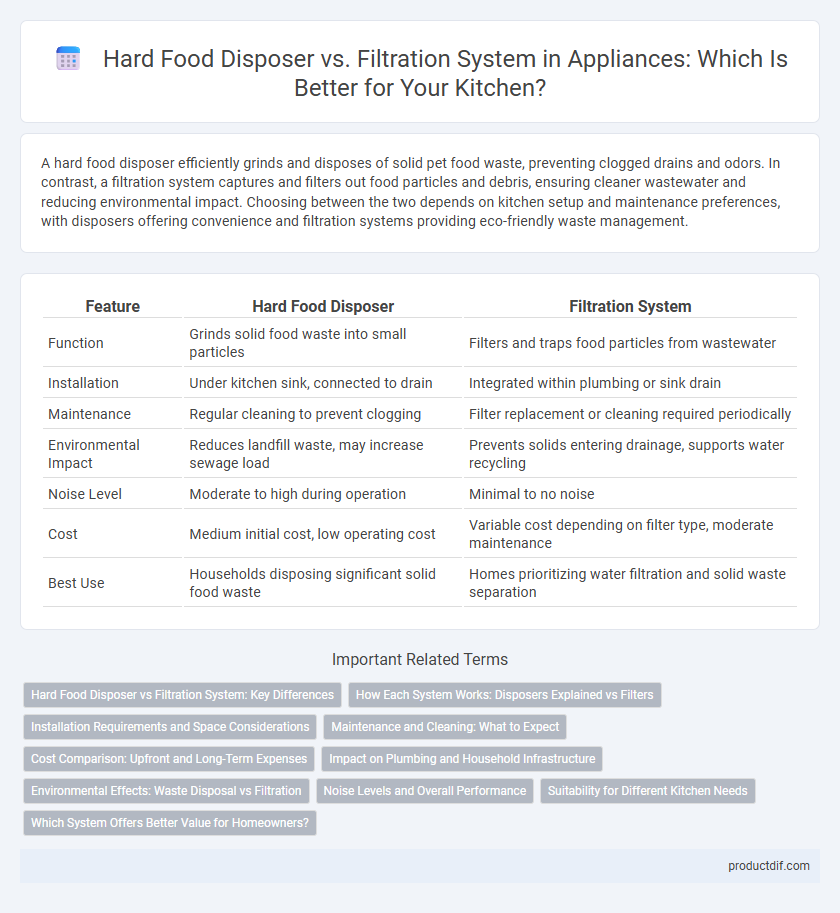A hard food disposer efficiently grinds and disposes of solid pet food waste, preventing clogged drains and odors. In contrast, a filtration system captures and filters out food particles and debris, ensuring cleaner wastewater and reducing environmental impact. Choosing between the two depends on kitchen setup and maintenance preferences, with disposers offering convenience and filtration systems providing eco-friendly waste management.
Table of Comparison
| Feature | Hard Food Disposer | Filtration System |
|---|---|---|
| Function | Grinds solid food waste into small particles | Filters and traps food particles from wastewater |
| Installation | Under kitchen sink, connected to drain | Integrated within plumbing or sink drain |
| Maintenance | Regular cleaning to prevent clogging | Filter replacement or cleaning required periodically |
| Environmental Impact | Reduces landfill waste, may increase sewage load | Prevents solids entering drainage, supports water recycling |
| Noise Level | Moderate to high during operation | Minimal to no noise |
| Cost | Medium initial cost, low operating cost | Variable cost depending on filter type, moderate maintenance |
| Best Use | Households disposing significant solid food waste | Homes prioritizing water filtration and solid waste separation |
Hard Food Disposer vs Filtration System: Key Differences
Hard food disposers use powerful grinding mechanisms to break down food waste into small particles, allowing it to be safely washed away through the plumbing system. Filtration systems, on the other hand, trap food particles and debris in a filter, preventing them from entering the drainage while requiring regular maintenance to clean or replace filters. Unlike disposers, filtration systems do not process waste but rely on physical barriers to manage solid residues.
How Each System Works: Disposers Explained vs Filters
Hard food disposers work by grinding food waste into small particles using a high-speed rotating impeller inside the disposal chamber, allowing the waste to be flushed through plumbing with water. Filtration systems operate by passing water through a fine mesh or activated carbon filter that captures solid particles and contaminants, preventing them from entering the drainage system. Disposers handle organic waste breakdown directly in the sink, while filtration systems focus on removing debris from wastewater before it reaches pipes.
Installation Requirements and Space Considerations
Hard food disposers require direct plumbing connections and electrical wiring, often necessitating under-sink space for installation and access. Filtration systems typically involve simpler installation with fewer mechanical parts, fitting easily into compact or cabinet spaces. Space considerations favor filtration systems in smaller kitchens, while disposers demand sufficient clearance and outlet access.
Maintenance and Cleaning: What to Expect
Hard food disposers require regular grinding of kitchen waste and occasional blade sharpening or replacement to maintain efficiency, while filtration systems demand routine filter changes and periodic deep cleaning to prevent clogging and odors. Filtration systems often have replaceable or washable filters that need monitoring for buildup, whereas food disposers may require unclogging if large particles cause jams. Proper maintenance of both ensures optimal appliance performance and extends their operational lifespan.
Cost Comparison: Upfront and Long-Term Expenses
Hard food disposers typically have lower upfront costs, ranging from $100 to $400, while filtration systems can cost between $200 and $800 depending on complexity. Over time, disposers may incur higher maintenance expenses due to frequent repairs or blade replacements, whereas filtration systems generally require periodic filter replacements that vary from $20 to $100 annually. Considering energy usage, disposers consume around 0.5 kWh per use, potentially increasing utility bills compared to low-energy filtration setups.
Impact on Plumbing and Household Infrastructure
Hard food disposers grind food waste into small particles that can be flushed easily through plumbing, reducing the risk of pipe blockages but potentially increasing the load on municipal sewage systems. Filtration systems trap solid particles before they enter the plumbing, preventing clogs and protecting household pipes but requiring regular maintenance and filter replacements. Choosing between these appliances depends on the household's plumbing capacity, local sewage regulations, and maintenance preferences.
Environmental Effects: Waste Disposal vs Filtration
Hard food disposers reduce landfill waste by grinding organic scraps directly into sewage systems, promoting natural decomposition in wastewater treatment plants. Filtration systems minimize water contamination by capturing food particles before they enter drainage, preventing nutrient pollution and eutrophication in aquatic ecosystems. Choosing between these appliances depends on prioritizing waste reduction or water quality preservation within environmental management strategies.
Noise Levels and Overall Performance
Hard food disposers typically produce higher noise levels due to their grinding motors, averaging around 70-80 decibels, while filtration systems operate more quietly at approximately 50-60 decibels by using passive filtering methods. In terms of overall performance, hard food disposers efficiently break down food waste to prevent kitchen clogs, though they require regular maintenance to avoid jams, whereas filtration systems excel in removing solid particles from wastewater but may need frequent filter replacements. The choice between the two depends on prioritizing quieter operation with moderate waste handling or powerful grinding with louder noise emissions.
Suitability for Different Kitchen Needs
Hard food disposers excel in households with heavy food waste, efficiently grinding scraps to prevent clogged drains and support eco-friendly waste management. Filtration systems are ideal for kitchens requiring water purification, improving water quality by removing sediments and contaminants for cooking and drinking purposes. Selecting between these appliances depends on whether the priority is waste disposal efficiency or enhanced water cleanliness based on specific kitchen requirements.
Which System Offers Better Value for Homeowners?
Hard food disposers provide efficient on-site disposal of kitchen waste, reducing the need for septic maintenance and immediately clearing food debris from drains. Filtration systems, on the other hand, enhance water quality by removing particulates and contaminants but do not address solid waste management. For homeowners prioritizing convenience and waste reduction, hard food disposers offer better value, while filtration systems are more beneficial for those focused on improving household water purity.
Hard Food Disposer vs Filtration System Infographic

 productdif.com
productdif.com